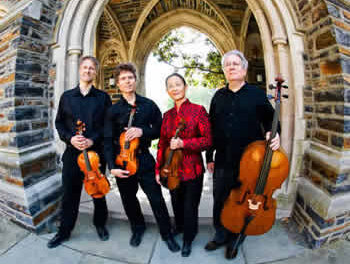A distressingly small turnout (about 30 hardy souls) greeted a fine program of contemporary music in the William S. Newman Series at UNC Chapel Hill, with works by two composers on their home turf (Allen Anderson and Stephen Anderson) joining pieces by visitor Mark Engebretson from UNC Greensboro.
Engebretson, a Minnesota native recently arrived in the South, is a skilled saxophonist as well as a composer, and his performing talents were featured in two works, “She Sings, She Screams,” and “Energy Drink I.” “She Sings” combined live alto saxophone with a pre-recorded electroacoustic track (what used to be called “tape” back in the day). The idiom was lyrical, but darkly so. The tape track served primarily as an acoustic backdrop for the cantabile of the sax, with little sharing of musical material a little later in the work nearer the climax, when it exchanged motives with the soloist. It is an attractive work, verging perhaps on the cinematographic.
“Energy Drink I,” for unaccompanied sax, was a kinetic and exciting tour-de-force for the soloist, exploiting the whole range of the instrument, from huge honking bass notes to screaming altissimo, and with a variety of extended techniques including multiphonics, singing while playing, and quarter-tones (in the latter, and indeed throughout, Engebretson’s control of intonation was superb).
Joining these works on the first half were three songs from a cycle of five by Allen Anderson, Instrument of the Tongue, to texts by Emily Dickinson, Robert Pinsky, and Alan Shapiro. The compositions were intimate, intricate, indrawing — important contributions to the song literature. Wonmin Kim’s accompaniment at the piano was first-rate. I was somewhat less taken by soprano Terry Rhodes, for a variety of technical reasons, which combined to make her projection of the text problematic, even as far as the sixth row. Her production tends to work against consistency of vowel sound (notable especially in the broad “as” of “at half-past,” which opened the Dickinson song), and this characteristic, combined with a considerable and ever-present vibrato, meant that the printed text was absolutely necessary to understanding what she was singing about.
The second half began with a long (twenty-minute) duet for vibraphone and piano by Stephen Anderson, who performed with virtuoso percussionist Christopher Deane. Individual moments could be striking, but the lack of variety of the material (chromatic clouds, and fifths), and more importantly, the unchanging emotional climate of the work (portentous, stentorian) meant that any technical structuring of the work was as naught in terms of bringing the listener along on a musical journey. In other words, “not enough butter spread over too much bread,” to quote Tolkien.
The concert concluded with Engebretson’s “SaxMax,” for soprano saxophone with live interactive computer (Susan Fancher, with Engebretson controlling the computer’s responses). Fancher is an exceptional player, with a beautiful tone and cantabile, each moment lovingly inflected. The computer enveloped her sax in a cloud of sophisticated echoes.
This work, and the program as a whole, gave the lie to the old canard about off-putting and rebarbative modern music. The pieces and performances should certainly have attracted five times the number of listeners from the Triangle, were it only possible to let them know how much enjoyment there was to be had. North Carolina can boast fine composers and performers of contemporary music — it is time for audience development to catch up.











